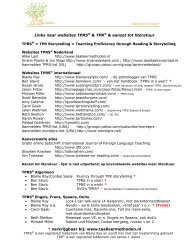TPRS in a Year - Taalleermethoden
TPRS in a Year - Taalleermethoden
TPRS in a Year - Taalleermethoden
You also want an ePaper? Increase the reach of your titles
YUMPU automatically turns print PDFs into web optimized ePapers that Google loves.
2. Did Zach <strong>in</strong>tend to dr<strong>in</strong>k some water or some milk yesterday? [Water] That‟s right, class, Zach<strong>in</strong>tended to dr<strong>in</strong>k some water yesterday.3. Did Zach <strong>in</strong>tend to dr<strong>in</strong>k some milk yesterday? [No] That‟s right, class, that‟s absurd. Zach didnot <strong>in</strong>tend to dr<strong>in</strong>k some milk yesterday. He <strong>in</strong>tended to dr<strong>in</strong>k some water yesterday.4. Class, what did Zach <strong>in</strong>tend to dr<strong>in</strong>k yesterday? [Water] That‟s right, class, Zach <strong>in</strong>tended todr<strong>in</strong>k some water yesterday.It is not <strong>in</strong>tended that you do all ten possibilities above. Instead, pick and choosedepend<strong>in</strong>g on the situation. This technique gets good personalization of thestructures, the students get needed repetitions, and the story will def<strong>in</strong>itely rollalong more easily with you hav<strong>in</strong>g done this. Stop the circl<strong>in</strong>g when the class showsconfidence <strong>in</strong> what you are say<strong>in</strong>g.Once the pattern is understood, you then have the option of mix<strong>in</strong>g it up. This is agood way to make students process each question at a higher level, result<strong>in</strong>g <strong>in</strong>greater ga<strong>in</strong>s. You have mastered this aspect of the skill when you can circle at will<strong>in</strong> random order without glanc<strong>in</strong>g at the chart.A word of caution, however. Too much random circl<strong>in</strong>g, though artful, can reallyconfuse the students. It is the old trap that many teachers fall <strong>in</strong>to with <strong>TPRS</strong>: theyth<strong>in</strong>k that because they get it, that their students naturally do as well.Circl<strong>in</strong>g need not be limited to normal classroom discussion (PQA and stories). TPRcommands, <strong>in</strong>clud<strong>in</strong>g those <strong>in</strong> the Three R<strong>in</strong>g Circus described later <strong>in</strong> this text, canbe circled as well. If you command Mark to “run,” once Mark has done so the<strong>in</strong>structor can then ask the class:Class, did Mark run? (yes)Did Mark or Ryan run? (Mark)Did Ryan run? (no)Did Derek run? (no)Did Mark run or walk? (run)Did Mark walk? (not)Did Mark swim? (no)Class, who ran? (Mark)If Mark then “ran to the left,” you can see how add<strong>in</strong>g just this one simple detailgreatly <strong>in</strong>creases the number of questions you can ask. Every time you add a detailto a discussion you greatly <strong>in</strong>crease what you can do with circl<strong>in</strong>g.Circl<strong>in</strong>g TPR commands and sentences <strong>in</strong> the Three R<strong>in</strong>g Circus builds greatconfidence <strong>in</strong> teachers new to <strong>TPRS</strong> because they are so easy to do. See Skill 8 formore <strong>in</strong>formation on the Three R<strong>in</strong>g Circus.I often repeat the same exact question three or four times <strong>in</strong> a row us<strong>in</strong>g differentemotions. One would th<strong>in</strong>k that this would bore the kids, but the kids can be fooled<strong>in</strong>to decod<strong>in</strong>g the same sentence multiple times by ask<strong>in</strong>g them questions <strong>in</strong> differentways us<strong>in</strong>g different emotions.



